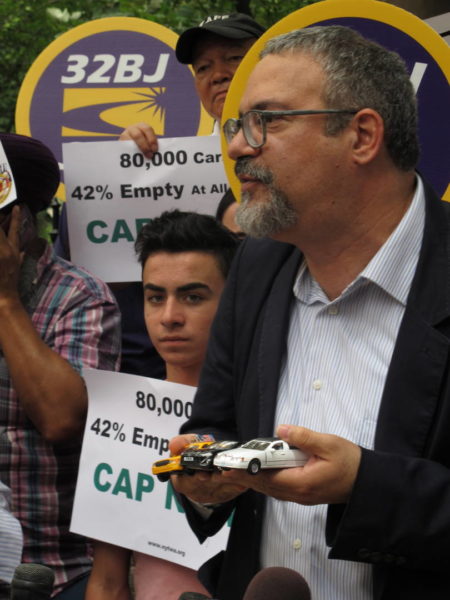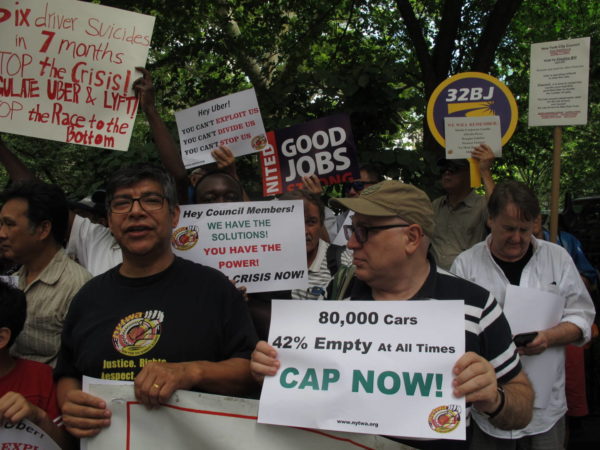NEW YORK, N.Y.—With the City Council on the eve of finalizing legislation to address the crisis in the taxi industry, more than 150 drivers and supporters rallied on Broadway outside City Hall July 31 to demand a cap on the number of vehicles.

“We see every day the impact of the gig economy on drivers and other workers,” 32BJ SEIU President Hector Figueroa told the crowd. “I don’t want to be in another press conference one year, two years, five years from now with photos of drivers who have lost their lives trying to feed their families.” He held up a toy yellow cab, black cab, and limousine to symbolize that all types of drivers are affected.
The New York Taxi Workers Alliance, which organized the rally, has been lobbying for a cap on the number of for-hire vehicles. With 130,000 now on the street, most of them added in the last few years as app-based taxi services expanded, it’s become increasingly difficult for drivers to make a living. Six drivers, all working long hours and under severe financial stress, have committed suicide since last November.
“Something has to give, and it can no longer be the drivers,” NYTWA executive director Bhairavi Desai said.
The Council has held hearings on five bills intended to regulate for-hire vehicles. It was expected to release a final version late that night, Desai told LaborPress after the rally. A vote has been scheduled for Aug. 8.
The bills include one sponsored by Councilmember Steve Levin (D-Brooklyn) which would stop the city from issuing new licenses for for-hire vehicles for a year—except for those wheelchair-accessible—pending the results of a study on the impact of the industry’s rapid expansion from app-based cabs. It might then authorize the city Taxi and Limousine Commission to limit the number of app-based cabs.
I don’t want to be in another press conference one year, two years, five years from now with photos of drivers who have lost their lives trying to feed their families. — 32BJ SEIU President Hector Figueroa
Another measure, sponsored by Ruben Diaz Sr. (D-Bronx) would require “high-volume transportation services,” such as Uber and Lyft, to get special licenses and prove the need for their services in the areas where they plan to operate. A third, sponsored by Brad Lander (D-Brooklyn), would allow the TLC to set minimum per-trip pay for drivers, specifically those dispatched by high-volume for-hire services.
The figure that for-hire vehicles are empty 42% of the time is “all you need to know,” Lander said. “There’s too many cars, too few riders. Drivers can’t make a living wage.”
Levin said that his bill would not decrease the number of for-hire vehicles on the street, just pause the increase. “We’ve reached an oversaturation point,” he told the crowd. The city now has twice as many for-hire vehicles as it had in 2015, when heavy lobbying by Uber pushed Mayor Bill de Blasio to drop plans to set a cap.

The Independent Drivers Guild, an organization of Uber drivers that long opposed a cap on vehicles, now supports one. “As a temporary measure, it’s a good thing,” executive director Ryan Price told LaborPress. “Something needs to be done now.”
The IDG had instead advocated a cap on the number of drivers, but Price says the Lander bill’s pay provisions would work as a de facto cap. Because the amount app-based services have to pay drivers would increase in proportion to the time the vehicle is empty, he explains, it would make it unprofitable for Uber to flood the city with more and more drivers.
Uber has argued that limiting the number of vehicles would force drivers to work more in the more profitable parts of Manhattan, and thus “hurt riders outside Manhattan who have come to rely on Uber because their communities have long been ignored by yellow taxis and do not have reliable access to public transit.”
“We aren’t taking away any service that is currently being offered,” Council Speaker Corey Johnson said in a statement. “We are pausing the issuing of new licenses in an industry that has been allowed to proliferate without any appropriate check.”
It would be “morally bankrupt” for the mayor and Council not to take action, Desai told the rally. Within six months after the failure of the 2015 cap bill, she said, Uber had saturated the streets with cabs, and in January 2016, it cut its fares, which drivers get a percentage of. The result, she continued is that 85% of app-based drivers make less than minimum wage after expenses.
While the legislation being proposed does not include the cap NYTWA has been calling for, “it’s a start,” Desai told LaborPress after the rally. “The fight is going to continue. Right now, we’re concentrating on page one.”

